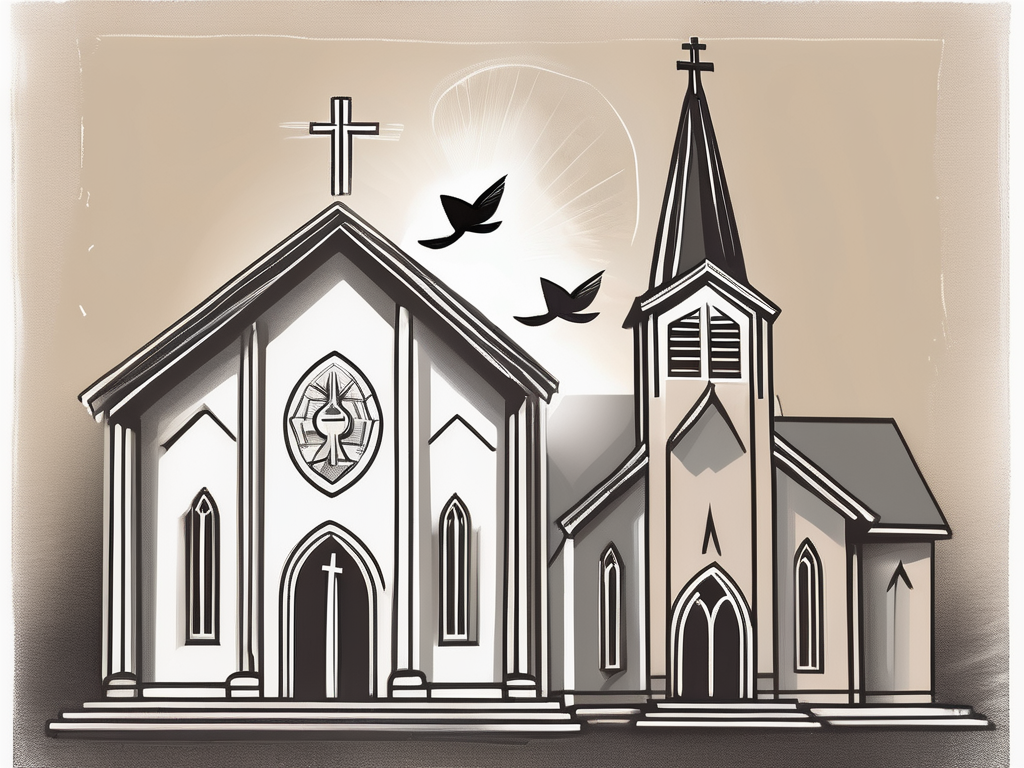In the world of Christianity, there are numerous denominations with their unique beliefs and practices. Two of the most prominent branches are Presbyterianism and Protestantism. While they both share a common foundation in their faith in Jesus Christ, they differ in their historical origins, key figures, core beliefs, and rituals. Understanding these differences can provide insights into the diverse tapestry of the Christian faith.
The Historical Background of Protestantism
Protestantism, a significant branch of Christianity, emerged as a result of the Reformation, a historical movement that began in the early 16th century. Led by individuals such as Martin Luther, John Calvin, and Huldrych Zwingli, the Reformation aimed to reform the existing practices of the Catholic Church, which had become increasingly corrupt and distant from the teachings of the Bible. The birth of Protestantism marked a significant division from Catholicism and introduced new principles and approaches to Christian worship.
The Reformation was a period of intense intellectual and theological debate, as scholars and religious leaders grappled with questions of authority, salvation, and the nature of the Church. Martin Luther, a German monk and theologian, played a central role in sparking the Reformation with his act of nailing the Ninety-Five Theses to the door of the Wittenberg Castle Church in 1517. This act challenged the Catholic Church’s selling of indulgences, which were seen as a way to buy forgiveness for sins. Luther’s bold action ignited a wide-scale movement of reform that highlighted the authority of the Bible and the importance of faith in salvation.
The Birth of Protestantism
The nailing of the Ninety-Five Theses was just the beginning of a larger movement that would reshape the religious landscape of Europe. As Luther’s ideas spread, they found resonance among many who were disillusioned with the corruption and excesses of the Catholic Church. The Protestant movement gained momentum, attracting followers who sought a more personal and direct relationship with God, free from the intermediaries and rituals of the Catholic Church.
One of the key principles that emerged from the Reformation was the concept of “sola scriptura,” meaning “Scripture alone.” Protestants emphasized the authority of the Bible as the ultimate source of religious truth, rejecting the Catholic Church’s claim to interpret Scripture and establish doctrine. This emphasis on individual interpretation and personal faith became a defining characteristic of Protestantism.
Key Figures in Protestantism
Protestantism saw the emergence of influential figures who played pivotal roles in shaping its doctrines and practices. Besides Martin Luther, other key figures include John Calvin and Huldrych Zwingli.
John Calvin, a French theologian, is known for his systematic theology and his emphasis on predestination and the sovereignty of God. His magnum opus, “Institutes of the Christian Religion,” became a foundational text for Reformed theology and had a profound influence on the development of Protestant thought.
Huldrych Zwingli, a Swiss reformer, advocated for a more symbolic interpretation of the Eucharist, rejecting the Catholic doctrine of transubstantiation. Zwingli’s teachings laid the groundwork for the development of Reformed and Presbyterian traditions within Protestantism.
These figures, among others, contributed to the rich tapestry of Protestant thought and theology. Their writings and teachings shaped the beliefs and practices of countless individuals and communities, leaving a lasting impact on the history of Christianity.
Spread and Influence of Protestantism
Over time, the influence of Protestantism extended beyond its European roots, spreading to different parts of the world through colonialism, missionary work, and migration. The Protestant movement found fertile ground in the Americas, where European settlers brought their religious beliefs and established Protestant colonies. In North America, various Protestant denominations took root, each with its own distinct traditions and interpretations of the faith.
Protestantism also made significant inroads in Africa, Asia, and other parts of the world through missionary efforts. Missionaries from Protestant denominations ventured into new territories, seeking to spread the Gospel and establish churches. Their work led to the formation of indigenous Protestant communities, blending Christian beliefs with local customs and traditions.
Today, Protestantism is one of the largest branches of Christianity, encompassing diverse groups such as Baptists, Methodists, Lutherans, and Pentecostals. Each denomination within Protestantism has its own unique history, theology, and worship practices, reflecting the diverse ways in which the Reformation and its ideas have been interpreted and applied over the centuries.
The historical background of Protestantism is a complex tapestry of ideas, events, and individuals. It is a story of religious reform, intellectual inquiry, and the pursuit of a more authentic and personal faith. The impact of Protestantism on the world cannot be overstated, as it continues to shape the beliefs and practices of millions of people around the globe.
The Emergence of Presbyterianism
Presbyterianism, a subset of Protestantism, emerged as a distinct denomination during the Reformation. It is characterized by its organization and governance, which is rooted in the principles established by John Calvin.
The Reformation, a period of religious upheaval in the 16th century, brought about significant changes in the Christian world. One of the key figures during this time was John Calvin, a French theologian and pastor. Calvin’s teachings emphasized the sovereignty of God and the importance of scripture in guiding the beliefs and practices of the church.
It was in Scotland, however, that Presbyterianism truly took shape. John Knox, a follower of Calvin, played a crucial role in its formation. Knox, influenced by Calvin’s teachings, sought to establish a church governed by a system of elders, known as presbyters, hence the name “Presbyterian.” This form of church governance seeks to ensure a balance of power and accountability amongst its leaders.
The Founding of Presbyterianism
The origins of Presbyterianism can be traced back to 16th-century Scotland, where John Knox, a follower of John Calvin, played a crucial role in its formation. Knox, influenced by Calvin’s teachings, sought to establish a church governed by a system of elders, known as presbyters, hence the name “Presbyterian.” This form of church governance seeks to ensure a balance of power and accountability amongst its leaders.
The establishment of Presbyterianism in Scotland was not without its challenges. The Catholic Church, which held significant power at the time, viewed the emerging denomination as a threat to its authority. Despite facing persecution and opposition, Presbyterianism continued to grow, attracting followers who were drawn to its emphasis on scripture and the involvement of the laity in church governance.
Over time, Presbyterianism spread beyond Scotland and found a home in other parts of Europe, as well as in North America. The principles of Presbyterianism resonated with many who sought a more democratic and participatory form of church governance.
Notable Leaders in Presbyterianism
Presbyterianism boasts a long line of notable leaders who have contributed significantly to the development of the denomination. One such leader is Jonathan Edwards, a key figure in the First Great Awakening in 18th-century America. Edwards, renowned for his powerful preaching and theological insights, is considered a leading theologian in Presbyterian history. His sermons, such as “Sinners in the Hands of an Angry God,” stirred the hearts of many and played a significant role in the spiritual revival that swept across the American colonies.
Other influential figures in Presbyterianism include John Witherspoon and Samuel Miller, who played important roles in shaping Presbyterianism in the United States. Witherspoon, a Scottish immigrant, served as the president of the College of New Jersey (now Princeton University) and was a signatory of the United States Declaration of Independence. His influence extended beyond the realm of education, as he actively participated in shaping the religious and political landscape of the young nation.
Samuel Miller, a prominent theologian and pastor, also made significant contributions to Presbyterianism in the United States. He served as a professor at Princeton Theological Seminary and was known for his scholarship and defense of Reformed theology. Miller’s writings and teachings continue to be influential in Presbyterian circles today.
The Global Impact of Presbyterianism
While Presbyterianism has its roots in Scotland, it has since spread throughout the world, influencing numerous cultures and societies. Today, Presbyterian denominations can be found worldwide, with a significant presence in countries such as the United States, South Korea, and Nigeria.
The global impact of Presbyterianism can be seen in its emphasis on education, social justice, and missionary work. Presbyterian churches have established numerous schools, colleges, and universities, providing education to countless individuals around the world. The commitment to education stems from the belief that an informed and educated congregation is better equipped to serve both the church and society.
Presbyterians have also been at the forefront of social justice movements, advocating for equality and justice in various contexts. From the civil rights movement in the United States to the anti-apartheid struggle in South Africa, Presbyterian voices have been raised in support of marginalized communities and the pursuit of a more just society.
Missionary work has also been a central aspect of Presbyterianism’s global impact. Presbyterian missionaries have traveled to far-flung corners of the world, sharing the message of the gospel and providing humanitarian aid to those in need. Their efforts have helped establish churches, schools, and medical facilities, leaving a lasting imprint on both local communities and the wider Christian landscape.
In conclusion, the emergence of Presbyterianism during the Reformation marked a significant development in the Protestant tradition. Its distinctive form of church governance, notable leaders, and global impact have shaped the denomination and continue to influence the lives of millions of people around the world.
Core Beliefs and Practices of Protestantism
Protestantism is characterized by several core beliefs and practices that set it apart from other branches of Christianity.
The Five Solas of Protestantism
- Sola Scriptura: The belief that the Bible is the ultimate authority in matters of faith and practice.
- Sola Fide: The belief that justification by faith alone is the means through which individuals are saved.
- Sola Gratia: The belief that salvation is a result of God’s grace alone and cannot be earned through human efforts.
- Sola Christus: The belief that salvation is through Christ alone, and that He is the only mediator between God and humanity.
- Soli Deo Gloria: The belief that all glory belongs to God alone and that all aspects of life should be lived to honor and glorify Him.
Sacraments in Protestantism
Protestant traditions generally recognize two sacraments: baptism and the Lord’s Supper (also known as Communion or the Eucharist). While the specific practices and interpretations may vary, these sacraments are seen as important acts of worship and remembrance in Protestant communities.
Protestant Worship and Liturgy
Protestant worship services are known for their simplicity and emphasis on the preaching of the Word. Worship typically involves singing hymns, prayers, and the reading and exposition of Scripture. While there is no unified liturgical structure across all Protestant denominations, the focus is often centered around the proclamation of God’s Word and seeking His presence through prayer and praise.
Fundamental Tenets and Rituals of Presbyterianism
Presbyterianism has its own distinctive beliefs and rituals, which reflect its governance and theological foundations.
Predestination in Presbyterianism
One of the key tenets of Presbyterianism is the belief in predestination. Predestination holds that God, in His sovereignty, has chosen certain individuals for salvation. This belief underscores the divine initiative in salvation and the idea that human actions are secondary to the will of God.
Presbyterian Sacraments
Presbyterian worship centers around two sacraments: baptism and the Lord’s Supper. Like other Protestant denominations, baptism is seen as a sign of initiation into the Christian faith, often administered through the sprinkling or immersion of water. The Lord’s Supper, or Communion, is viewed as a symbolic commemoration of Christ’s sacrifice and is usually celebrated through the sharing of bread and wine.
The Structure of Presbyterian Worship
Presbyterian worship services typically follow a structured order, known as the liturgy. This order may include elements such as prayers, hymns, Scripture readings, and a sermon. The sermon holds particular significance in Presbyterian worship, emphasizing the exposition and application of biblical teachings to the lives of believers. The aim is to inspire spiritual growth and foster a deeper understanding of God’s Word.
As we have explored, Presbyterianism and Protestantism may share some common ground, but they also have distinguishing characteristics that shape their respective identities. While Protestantism as a whole encompasses a wider range of beliefs and practices, Presbyterianism offers a unique perspective on governance, theology, and worship. These differences enrich the tapestry of Christian traditions, providing believers with various avenues to explore and deepen their faith in Jesus Christ.












